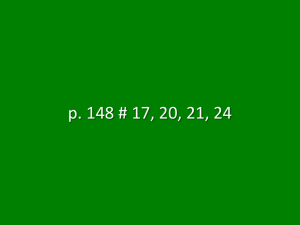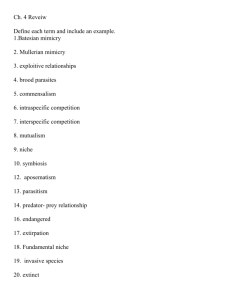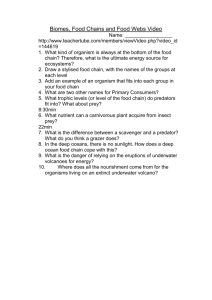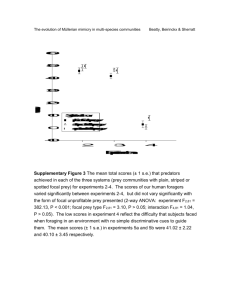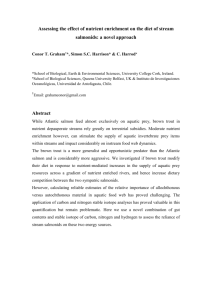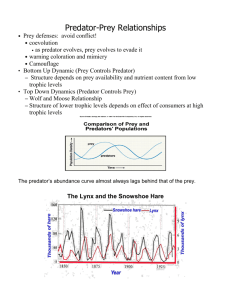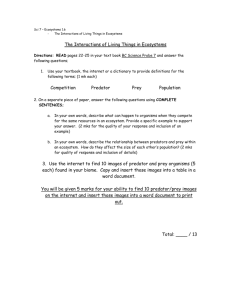Growth Potential
advertisement
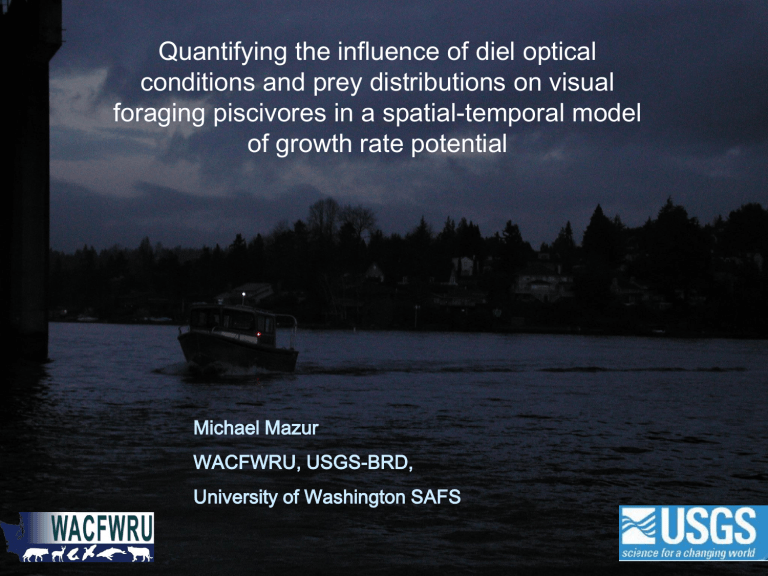
Quantifying the influence of diel optical conditions and prey distributions on visual foraging piscivores in a spatial-temporal model of growth rate potential Michael Mazur WACFWRU, USGS-BRD, University of Washington SAFS Objectives and road map Investigate how alterations in diel optical conditions and prey distributions influence the variation in growth of piscivorous cutthroat trout in Lake Washington Model structure Models within the model Data collection and inputs Results and model corroboration Conclusion Spatially explicit growth potential model Prey distribution Prey supply Foraging model Growth rate o Temperature C 6 12 18 0 20 30 40 50 Depth (m) 10 Temperature Bioenergetics model Predator demand Foraging Model Fish are primarily visual oriented foragers (Ali 1959) 0.08 NTU - 0.55 NTU 120 Lake trout model Reaction distance (cm) 100 80 Cutthroat trout model 60 Rainbow trout model 40 Lake trout 0.08 NTU Rainbow trout 0.08 NTU Cutthroat trout 0.08 NTU 20 Lake trout 0.55 NTU Rainbow trout 0.55 NTU Cutthroat trout 0.55 NTU 0 0 10 20 30 40 Light (Lx) 50 60 70 80 Search Volume = ‘cylinder’ Reaction Distance Swim speed x foraging duration Search Volume = ∏ x RD2 x (SS x time) Encounter Rate = Search Volume x Prey Density RD RD = f(depth, light, turbidity) Because RD and SS are functions of light Piscivores trade-off between light and prey Foraging model is a tool for filtering prey densities down into the amount of prey available for a predator Foraging sequence P(Capture) = P(Encounter) * P(Attack) * P(Success given attack) * P(Retain) all prey morphology space Visual feeding fishes Light and Turbidity time perceptual field available prey Spatially explicit growth potential model Prey distribution Prey supply Foraging model Growth rate o Temperature C 6 12 18 0 20 30 40 50 Depth (m) 10 Temperature Bioenergetics model Predator demand Bioenergetics, coverts consumption into growth Mass Balance Approach -Theoretical basis in laws of thermodynamics Consumption = Metabolism + Waste + Growth Metabolism (respiration, active metabolism, specific dynamic action) Waste (egestion, excretion) Consumption Growth Road map Model structure Models within the model Data collection and inputs Results and model corroboration Conclusion Prey densities Hydroacoustic estimates of Temporal-spatial prey densities Month/season Diel Areas of the lake Mid-water trawl estimates of species identification and size of prey Area 1 Area 3 Area 4 Depth (m) Area 2 0 10 20 30 40 50 60 0 10 20 30 40 50 60 0 10 20 30 40 50 60 0 10 20 30 40 50 60 0 10 20 30 40 50 60 February, Area 1 < 70 mm 70 - 150 mm > 150 mm February, Area 2 Distribution of Prey February, Area 3 February, Area 4 February, Area 5 Density (Fish / 1000 m3) Area 5 0 2 4 6 8 10 12 14 Reaction distance (cm) 0 0 20 40 60 20 40 60 Spring Winter 20 40 60 20 40 60 Summer Depth (m) 15 30 RD Fall 45 Seasonal & Diel prey densities Day Prey fish (40-150 mm) 60 0 Depth (m) 15 Crepuscular 30 45 Urban light pollution 60 0 Depth (m) 15 Night 30 45 60 Prey fish 0 4 8 12 16 4 8 12 16 4 8 12 16 Prey fish / 1000 m3 4 8 12 16 20 sockeye fry sockeye ps 0+ smelt 1+ smelt stickleback stickleback Winter 2003 Prey fish Density Day 0 30 60 Night 0 30 60 Day Prey fish densities Night 0 0 30 30 60 0 60 0 30 30 60 0 60 0 30 30 60 60 0 0 30 30 60 0 60 0 30 30 60 Area 3 only 0 60 0 30 30 60 Area 3 only 0 60 0 30 30 60 Area 3 only Prey fish / m3 60 Spring 2002 Summer 2002 Fall 2002 Winter 2003 Spring 2003 Summer 2003 Fall 2003 Road map Model structure Models within the model Data collection and inputs SE Results and corroboration Conclusion Growth potential 0 20 40 Spring 2002 (night) One mid-lake transect 60 20 40 Summer 2002 (night) Depth (m) 60 Smelt reach 40 mm 20 40 Fall 2002 (night) 60 20 40 Winter 2003 (night) 60 20 40 Spring 2003 (night) 60 -0.002 0 0.003 0.008 0.013 0.02 Growth Potential (g/g/day) Winter 2003 Day 0 30 60 Night 0 30 60 Growth Potential (g/g/day) Day Night Growth Potential 0 0 30 30 60 0 60 0 30 30 60 0 60 0 30 30 60 60 0 0 30 30 60 0 60 0 30 30 60 Area 3 only 0 60 0 30 30 Area 3 only 60 0 60 0 30 30 60 Area 3 only Growth Potential (g/g/day) 60 Spring 2002 Summer 2002 Fall 2002 Winter 2003 Spring 2003 Summer 2003 Fall 2003 0.3 0.2 Day 0.3 Night May 2002 0.2 Proportion positive growth cells 0.1 0.1 0.3 0.3 August 2002 0.2 0.2 0.1 0.1 0.3 0.3 October 2002 0.2 0.2 0.1 0.1 0.3 0.3 February 2003 0.2 0.2 0.1 0.1 0.3 0.2 0.3 May 2003 0.2 * * * * No data available 0.1 0.0 5 4 3 0.1 0.0 2 1 No consistent trends 5 4 3 2 Lake Area (South to North) 1 Area 4 generally highest Daytime estimate winter 04 fall 03 summer 03 spring 03 winter 03 fall 02 summer 02 spring 02 3.75 220 Cutthroat trout condition Slope 200 3.25 180 3.00 160 140 Back calculated growth age 3-4 Back calculated Annual growth Agrees with GP estimates 120 100 0.25 Cutthroat trout growth potential Delayed response 0.20 0.15 Cutthroat trout condition 0.10 Winter and spawning may contribute 0.05 0.007 winter 04 fall 03 summer 03 spring 03 winter 03 fall 02 summer 02 0.00 spring 02 Proportion of positive cells 2.75 Growth (g/year) 3.50 240 May 2003 Constant 0.5 m RD Night 0 30 Constant RD increased the value of dark deep water habitat to the growth of cutthroat trout 60 0 Light-dependent RD Night 30 60 Growth Potential (g·g-1·day-1) Conclusions • The growth potential model was able to transform general prey abundances into a quantifiable characteristic of the environment with implications for both predators and prey • Light-dependent foraging models improve the predictive capability of growth potential models • The growth potential model reflected annual changes in growth and seasonal shifts in condition for cutthroat trout • Despite variable prey densities among areas of the lake, cutthroat trout growth was predicted to be more dependent on vertical variability in foraging opportunity Acknowledgments: David Beauchamp Pat Nielsen, John Horne, Danny Grunbaum, Dan Yule, Chris Luecke Tom Lowman Beauchamp grad students- Jen McIntyre! Lab and field help- Andy Jones, Chris S., Mike, Jo, Jim, Steve, Robert, Nathanael, Angie, Mistie, Chris B., Kenton, Shannon, Bridget, Lia Coop Unit- Chris Grue, Verna, Martin, Dede, Barbara WDFW- Chad Jackson, Casey Baldwin Funding: Utah Coop Unit, UDWR WACFRU, King County (SWAMP) City of Seattle, City of Bellevue
